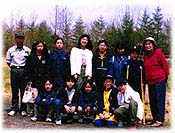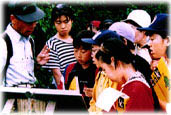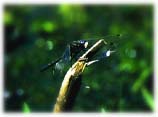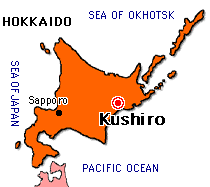Discovering the Riches of Hokkaido's Wetlands
--Kushiro Kid's Eco Club--
 The Kushiro Kids' Eco Club was formed in June 1996 with 10 fifth graders attending three elementary schools in the city of Kushiro, Hokkaido.
The Kushiro Kids' Eco Club was formed in June 1996 with 10 fifth graders attending three elementary schools in the city of Kushiro, Hokkaido.
Currently, meetings are held on the second and fourth Saturdays of each month, and two volunteer rangers at the Kushiro Shitsugen (marshland) National Park support the club's activities.
Because club members live near this vast marsh, where 60% of Japan's wetlands are contained and which is protected by the Ramsar Convention on Wetlands (an international agreement to protect swamps and marshes), they decided to acquaint themselves with this unique ecosystem.
The Kushiro Eco Club's activities have included observing cranes, dragonflies, and plants in the marshland. In July last year, fossil shells were excavated, proving that the area was under water in ancient times. The members were excited to discover that the shells were a species that lived in warmer climates, suggesting that snowy Kushiro was must warmer in the past than it is today.
 "It was great fun spotting and observing various insects, particularly dragonflies," a club member commented. "Our volunteer rangers helped us find some rare dragonfly species that are designated natural monuments in Japan."
"It was great fun spotting and observing various insects, particularly dragonflies," a club member commented. "Our volunteer rangers helped us find some rare dragonfly species that are designated natural monuments in Japan."
Research on dragonflies
Between June and October 1996, extensive research on the lives and habitats of dragonflies that live around a pond called Ashimi Ike was conducted. The pond is located near Kushiro Marsh and is also close to the schools that club members attend. This enabled participants to deepen their awareness of environmental issues where they live.
Nineteen species of dragonfly were observed. At each sighting, the temperature, wind velocity, species, and gender were noted. Members also took notes of how the dragonflies behaved and what they looked like. In September, a female dragonfly was seen laying eggs by putting its tail into the water.
 The research results were compiled into a booklet, complete with photographs of each dragonfly and facts surrounding each observation. The booklet was published in March this year.
The research results were compiled into a booklet, complete with photographs of each dragonfly and facts surrounding each observation. The booklet was published in March this year.
"We learned a very important lesson from these activities," a club member reflected. "We realized that we have to do our best preserve our environment so that these dragonflies, along with other species, can continue to live in safety and peace."
This year's activities
The club's activities this year will include field observations of the Kushiro Marsh and further research of the dragonflies in Ashimi Pond. Members will also participate in environment-related activities organized by other groups, such as cleaning up litter left behind in parks and learning horseback riding. There are 11 members from two elementary schools participating this year.
"The focus of last year's activities was on dragonflies," a member of this year's club commented. "There's still a lot to be learned about them, and so we're looking forward to making new discoveries this year. We also hope to learn about taking better care of our planet."
Photos: (Top) The members and rangers of the club; (middle) learning about the wetlands (Yoko Niisato); (above) and Ezokaojiro (Hokkaido white-faced) dragonfly (Seiji Sasaki).



 The Kushiro Kids' Eco Club was formed in June 1996 with 10 fifth graders attending three elementary schools in the city of Kushiro, Hokkaido.
The Kushiro Kids' Eco Club was formed in June 1996 with 10 fifth graders attending three elementary schools in the city of Kushiro, Hokkaido.
 "It was great fun spotting and observing various insects, particularly dragonflies," a club member commented. "Our volunteer rangers helped us find some rare dragonfly species that are designated natural monuments in Japan."
"It was great fun spotting and observing various insects, particularly dragonflies," a club member commented. "Our volunteer rangers helped us find some rare dragonfly species that are designated natural monuments in Japan."
 The research results were compiled into a booklet, complete with photographs of each dragonfly and facts surrounding each observation. The booklet was published in March this year.
The research results were compiled into a booklet, complete with photographs of each dragonfly and facts surrounding each observation. The booklet was published in March this year.
![]()